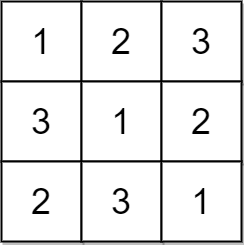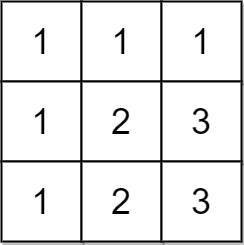| comments | difficulty | edit_url | rating | source | tags | |||
|---|---|---|---|---|---|---|---|---|
true |
Easy |
1264 |
Weekly Contest 275 Q1 |
|
An n x n matrix is valid if every row and every column contains all the integers from 1 to n (inclusive).
Given an n x n integer matrix matrix, return true if the matrix is valid. Otherwise, return false.
Example 1:
Input: matrix = [[1,2,3],[3,1,2],[2,3,1]] Output: true Explanation: In this case, n = 3, and every row and column contains the numbers 1, 2, and 3. Hence, we return true.
Example 2:
Input: matrix = [[1,1,1],[1,2,3],[1,2,3]] Output: false Explanation: In this case, n = 3, but the first row and the first column do not contain the numbers 2 or 3. Hence, we return false.
Constraints:
n == matrix.length == matrix[i].length1 <= n <= 1001 <= matrix[i][j] <= n
Traverse each row and column of the matrix, using a hash table to record whether each number has appeared. If any number appears more than once in a row or column, return false; otherwise, return true
The time complexity is
class Solution:
def checkValid(self, matrix: List[List[int]]) -> bool:
n = len(matrix)
return all(len(set(row)) == n for row in chain(matrix, zip(*matrix)))class Solution {
public boolean checkValid(int[][] matrix) {
int n = matrix.length;
boolean[] vis = new boolean[n + 1];
for (var row : matrix) {
Arrays.fill(vis, false);
for (int x : row) {
if (vis[x]) {
return false;
}
vis[x] = true;
}
}
for (int j = 0; j < n; ++j) {
Arrays.fill(vis, false);
for (int i = 0; i < n; ++i) {
if (vis[matrix[i][j]]) {
return false;
}
vis[matrix[i][j]] = true;
}
}
return true;
}
}class Solution {
public:
bool checkValid(vector<vector<int>>& matrix) {
int n = matrix.size();
bool vis[n + 1];
for (const auto& row : matrix) {
memset(vis, false, sizeof(vis));
for (int x : row) {
if (vis[x]) {
return false;
}
vis[x] = true;
}
}
for (int j = 0; j < n; ++j) {
memset(vis, false, sizeof(vis));
for (int i = 0; i < n; ++i) {
if (vis[matrix[i][j]]) {
return false;
}
vis[matrix[i][j]] = true;
}
}
return true;
}
};func checkValid(matrix [][]int) bool {
n := len(matrix)
for _, row := range matrix {
vis := make([]bool, n+1)
for _, x := range row {
if vis[x] {
return false
}
vis[x] = true
}
}
for j := 0; j < n; j++ {
vis := make([]bool, n+1)
for i := 0; i < n; i++ {
if vis[matrix[i][j]] {
return false
}
vis[matrix[i][j]] = true
}
}
return true
}function checkValid(matrix: number[][]): boolean {
const n = matrix.length;
const vis: boolean[] = Array(n + 1).fill(false);
for (const row of matrix) {
vis.fill(false);
for (const x of row) {
if (vis[x]) {
return false;
}
vis[x] = true;
}
}
for (let j = 0; j < n; ++j) {
vis.fill(false);
for (let i = 0; i < n; ++i) {
if (vis[matrix[i][j]]) {
return false;
}
vis[matrix[i][j]] = true;
}
}
return true;
}
